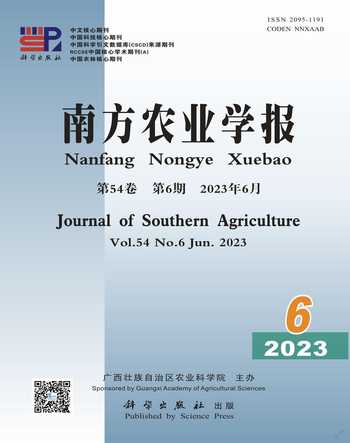不同质量浓度MS-222对红尾副鳅麻醉效果的影响
2023-11-02肖贵榜张浩然黄胜赵谱远杨玉能鲍娟周林陆武军廖丽姜秋霞
肖贵榜 张浩然 黄胜 赵谱远 杨玉能 鲍娟 周林 陆武军 廖丽 姜秋霞
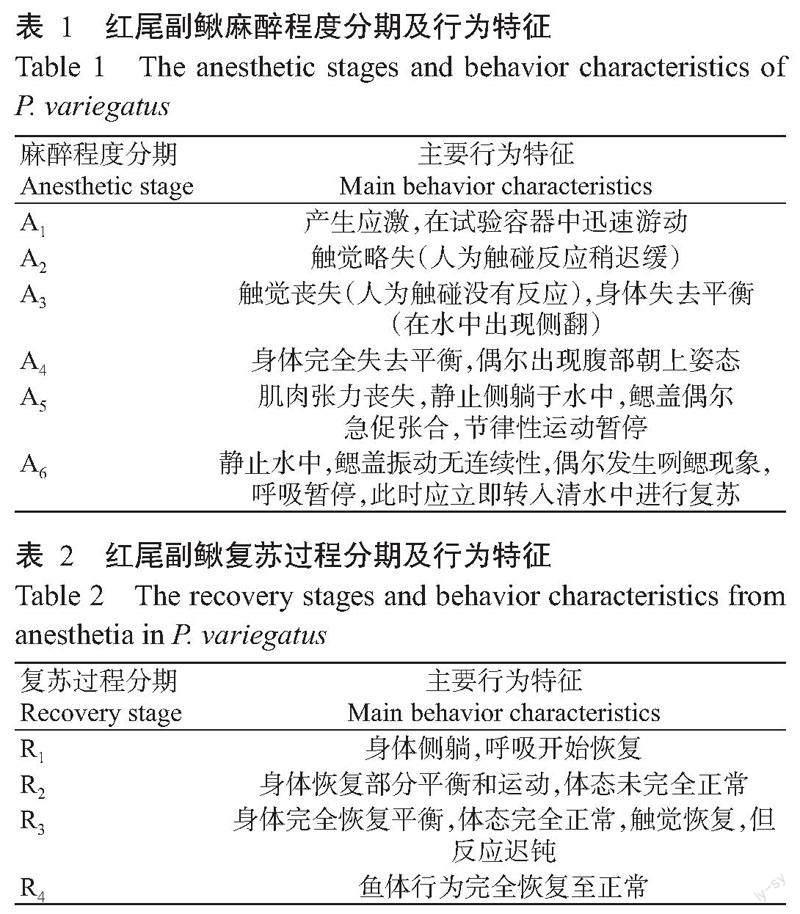
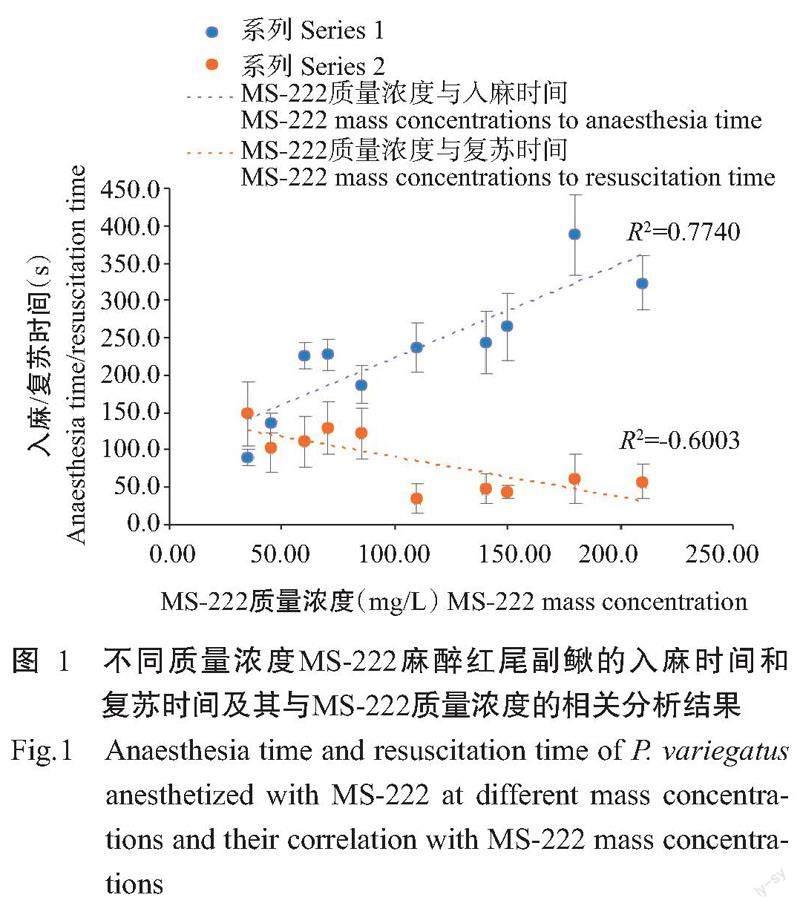
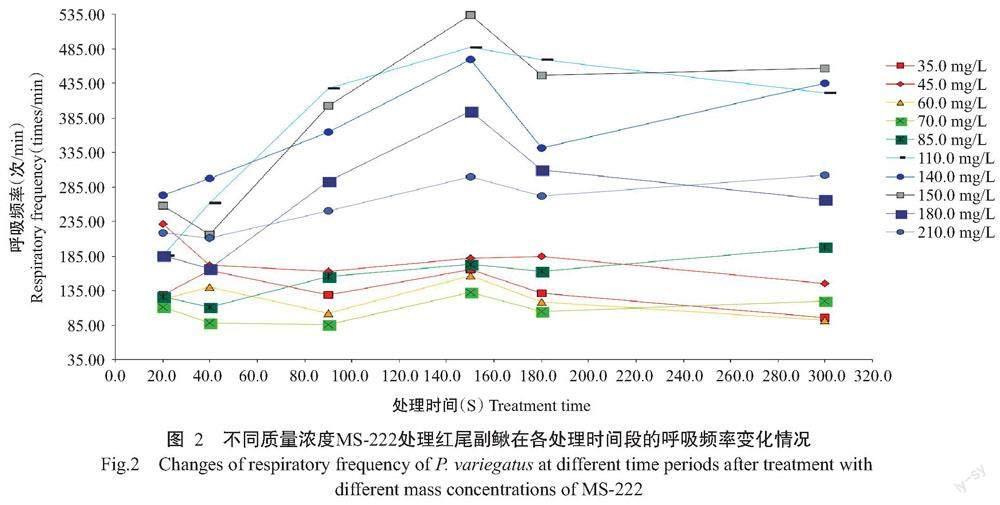
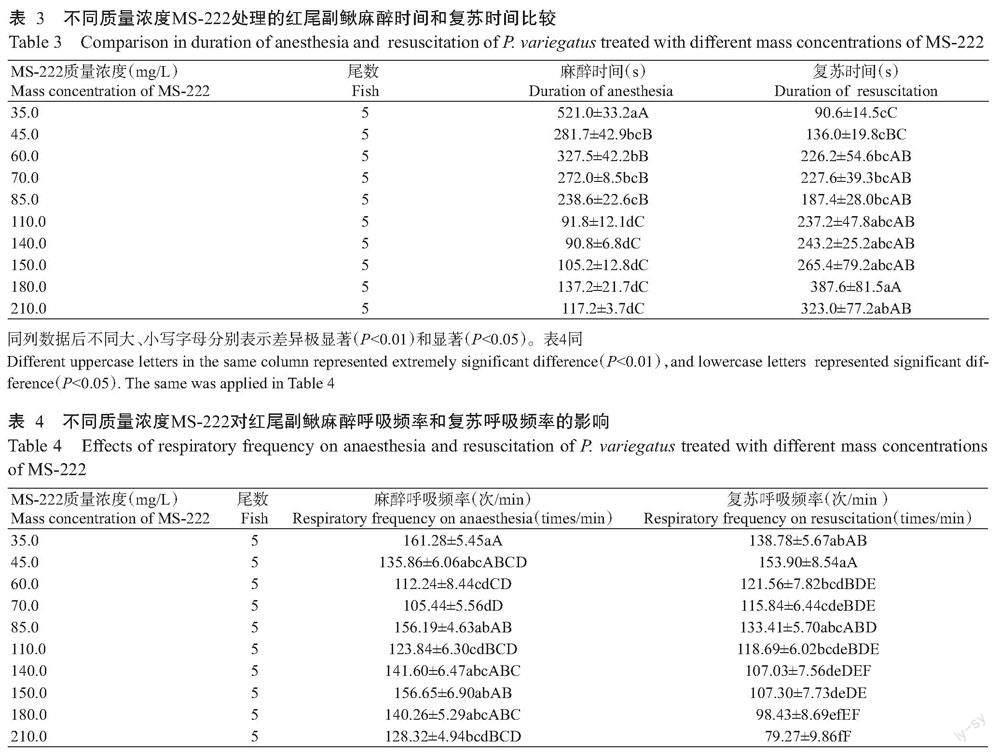
DOI:10.3969/j.issn.2095-1191.2023.06.030
摘要:【目的】探究不同質量浓度间氨基苯甲酸乙酯甲磺酸盐(MS-222)对红尾副鳅(Paracobitis variegatus)的麻醉效果及其生理行为特征,为鱼类野外活体样本采集、驯养和繁育等科研生产活动提供麻醉技术并丰富鱼类麻醉理论。【方法】采用静水生物测试法,设置35.0、45.0、60.0、70.0、85.0、110.0、140.0、150.0、180.0和210.0 mg/L共10组MS-222质量浓度进行红尾副鳅麻醉试验,检测不同质量浓度MS-222药浴红尾副鳅后的麻醉和复苏阶段经过时间及呼吸频率,筛选适宜红尾副鳅驯养、繁育和疾病防治的MS-222麻醉剂质量浓度。【结果】依据MS-222麻醉红尾副鳅后其不同呼吸频率和行为特征,可将红尾副鳅麻醉程度分为应激期、轻度镇静期、深度镇静期、轻度麻醉期、麻醉期和深度麻醉期(A1~A6期)6个麻醉阶段,将复苏过程分为复苏期1~复苏期4(R1~R4期)4个复苏等级;10个质量浓度MS-222麻醉均能使红尾副鳅达到A6阶段,且均能复苏至R4等级。相关分析结果表明,MS-222质量浓度与麻醉时间呈显著负相关(R²=-0.6003)(P<0.05,下同),与复苏时间呈显著正相关(R²=0.7440);麻醉剂量均显著影响红尾副鳅的麻醉与复苏。各质量浓度MS-222处理红尾副鳅的呼吸频率均呈波浪式变化,麻醉和复苏阶段的呼吸频率均存在差异。在充氧条件下,35.0~210.0 mg/L MS-222处理红尾副鳅的复苏率均达100.0%。【结论】不同质量浓度MS-222处理红尾副鳅在麻醉和复苏阶段的呼吸频率均存在差异,理想的麻醉浓度区间为45.0~180.0 mg/L,110.0~180.0 mg/L的MS-222可用于红尾副鳅短时麻醉,45.0~85.0 mg/L的MS-222可用于红尾副鳅较长时间麻醉。
关键词:红尾副鳅;间氨基苯甲酸乙酯甲磺酸盐(MS-222);麻醉效果;复苏率;呼吸频率
中图分类号:S965.199 文献标志码:A 文章编号:2095-1191(2023)06-1884-09
Anesthetic effect of MS-222 at different mass concentrations on Paracobitis variegatus
XIAO Gui-bang1, 2, ZHANG Hao-ran3, HUANG Sheng3, ZHAO Pu-yuan3,
YANG Yu-neng1, BAO Juan1, ZHOU Lin1, LU Wu-jun1, LIAO Li1, JIANG Qiu-xia4
(1Department of Modern Agriculture, Zunyi Vocational and Technical College, Zunyi, Guizhou 563000, China; 2Department of Biochemistry and Molecular Biology, West China School of Basic Medical Sciences & Forensic Medicine , Sichuan University, Chengdu, Sichuan 610041, China; 3Guizhou Ecological Fishery Co., Ltd., Guiyang, Guizhou 550022, China; 4School of Biological Sciences, Guizhou Education University, Guiyang, Guizhou 550018,China)
Abstract:【Objective】This paper investigated the physiological behavior characteristics of Paracobitis variegatus and the anesthetic effects of various concentrations of 3-aminobenzoic acid ethyl ester methanesulfonate(MS-222) in order to provide anesthesia technical support for the collection of live fish samples in the wild, fish domestication and breeding, and to advance the theory of fish anesthesia. 【Method】Ten groups of MS-222 were set up with the mass concentrations of 35.0, 45.0, 60.0, 70.0, 85.0, 110.0, 140.0, 150.0, 180.0 and 210.0 mg/L to carry out the anaesthesia test of P. variegatus, using static water bioassay. Duration of anesthesia and resuscitation, and the respiratory frequency of P. variegatus under MS-222 immersion baths of different mass concentrations was measured so as to screen mass concentrations of MS-222 anesthetics suitable for domestication, breeding and disease control of P. variegatus. 【Result】Based on different respiratory frequencies and behavioral characteristics after treatment of MS-222 of P. variegatus, the anesthesia degrees could be divided into 6(A1-A6) anesthesia stages: irritability, slight sedation, deep sedation, slight anesthesia, anesthesia and deep anesthesia, and resuscitation duration was divided into 4 resuscitation levels, namely resuscitation stage 1-resuscitation stage 4(R1-R4). All the 10 mass concentrations of MS-222 could make P. variegatus reach the A6(deep anesthesia), and resuscitate to the R4 level. According to correlation analysis, significant negative correlations were found between the mass concentration of MS-222 and anesthesia time(R²=0.6003)(P<0.05, the same below), and the mass concentration of MS-222 significantly positively correlated with resuscitation time(R²=0.7440); the anesthetic dose significantly affected the anesthesia and resuscitation of P. variegatus. Different mass concentrations of MS-222 had a wavy variation in the respiratory frequency of treated P. variegatus. There were differences in respiratory frequency between anesthesia stage and resuscitation stage with different mass concentrations of MS-222. Under oxygenation, the resuscitation rate of P. variegatus treated with MS-222 at the concentration of 35.0-210.0 mg/L reached 100.0%. 【Conclusion】The respiratory frequency of P. variegatus treated with different mass concentrations of MS-222 is discrepant during the anesthesia and the resuscitation stages. The ideal anesthetic concentration of MS-222 for P. variegatus is 45.0-180.0 mg/L. MS-222 at the concentration of 110.0-180.0 mg/L can be used for short-term anesthesia of P. variegatus, while MS-222 at the concentration of 45.0-85.0 mg/L can be used for long-term anesthesia of P. variegatus.
Key words: Paracobitis variegatus; 3-aminobenzoic acid ethyl ester methanesulfonate(MS-222); anesthesia effect; resuscitation rate; respiratory frequency
Foundation items: Guizhou Science and Technology Plan Project(QKHZC〔2020〕1Y103)
0 引言
【研究意義】水生动物麻醉剂有乙醚、美托味酯、间氨基苯甲酸乙酯甲磺酸盐(MS-222)、丁香酚、2-苯氧乙醇和苯唑卡因等(杜浩等,2007;刘长琳等,2008;He et al.,2020)。MS-222作为一种肌肉松弛剂,能阻断神经膜上的钠电流和少量钾电流(Jennifer and Robert,2021),且在清水中活鱼肌肉内代谢时间较短(任洁等,1997)因此被美国食品和药物管理局(FDA)批准为用于食用鱼的唯一麻醉剂,并广泛应用于鱼类活体运输、免疫和激素注射、亲鱼采卵采精、标志放流及外科手术等领域(韩光明等,2015)。红尾副鳅(Paracobitis variegatus)隶属于鲤形目鳅科副鳅属,是分布于我国汉江支流源流、堵河、长江支流沿渡河及金沙江、南盘江和渭河水系等水域的特有小型经济食用鱼类(杨君兴等,1994;周中艳等,2007),因其体色艳丽,还可兼作观赏鱼类。近年来,因受生存环境恶化和过度捕捞的影响,红尾副鳅资源已急剧减少(杜宗君等,2013),亟待开展红尾副鳅驯化、繁育和人工养殖研究以保护和持续利用该物种资源(肖贵榜等,2021),而开展红尾副鳅生物学、生态学、人工驯养、繁殖及种质资源保护研究等工作需适度使用水产麻醉剂(丁亚涛等,2019),但目前使用MS-222麻醉红尾副鳅的剂量尚不清楚。因此,探究不同浓度MS-222麻醉后红尾副鳅的行为特征,对红尾副鳅及其他鱼类野生活体的样本采集、驯养、繁育及丰富鱼类麻醉理论具有重要意义。【前人研究进展】国内学者已开展MS-222麻醉斑马鱼(Danio rerio)(Huang et al.,2010)、尖吻鲈(Lates calcarifer)(Xue et al.,2017)、暗纹东方鲀(Takifugu obscurus)、草鱼(Ctenopharyngodon idellus)和鲫(Carassius auratus)(陈永平等,2019)、鳊(Parabramis pekinensis)(丁亚涛等,2019)、硬头鳟(Oncorhynchusmykis)(李乐等,2019)、黄颡鱼(Pelteobagrus fulvidraco)(林丽珍等,2019;刘阳等,2021;Liu et al.,2022)、大鳞鲃(Luciobarbus capito)(张龙岗等,2019)、花鲈(Lateolabrax maculatus)(Wang et al.,2020)、银鲳(Pampus argenteus)(Yu et al.,2020)、亚东鲑(Salmon trutta)(王金林等,2021)、黄条鰤(Seriola aureovittata)(王维鑫等,2021)、凡纳滨对虾(Litopenaeus vannamei)(徐德峰等,2021)、大黄鱼(Larimichthys crocea)(杨乐等,2021;章霞等,2022)、史氏鲟(Acipenser schrencki)(周文等,2021)、大菱鲆(Scophthalmus maximus)(Cao et al.,2021)、细鳞鲑(Brachymystax lenok)和美洲红点鲑(Salvelinus fontinalis)(彭思博等,2022)等的研究,主要分析MS-222处理试验鱼的呼吸频率、麻醉后空气暴露复苏、保活运输中的抗氧化应激、MS-222在鱼体组织中富集、消除及对鱼体内酶活性的影响等。国外学者主要开展MS-222对模式动物斑马鱼(Felix et al.,2020,2021;Zanin et al.,2020;Leyden et al.,2022)及海产鱼类大西洋鲑(Salmo salar)(Chance et al.,2018)、金头鲷(Sparus aurata)(Jerez-Cepa et al.,2019)、克林雷氏鲶(Rhamdia quelen)(Teixeira et al.,2021)和三刺鱼(Gasterosteus aculeatus)(Barnes et al.,2023)等的联合用药、胚胎发育、生殖激素调控及生殖细胞影响方面的研究。目前,国外学者采用MS-222麻醉鳅科鱼类的研究较少,而国内研究人员采用MS-222对鳅科鱼类进行麻醉仅主要涉及长薄鳅(Leptobotia elongata)(张建明等,2014)、泥鳅(Misgurnus anguillicaudatus)(韩光明等,2015)、西昌华吸鳅(Sinogastromyzon sichangensis)、峨眉后平鳅(Metahomaloptera omeiensis)(胡佐灿等,2019)和四川华吸鳅(S. szechuanensis)(陈小江等,2020)。【本研究切入点】迄今,针对MS-222麻醉红尾副鳅效果及其生理行为特征的研究未见报道。【拟解决的关键问题】采用静水生物测试法进行红尾副鳅MS-222麻醉试验,探究不同浓度MS-222麻醉的红尾副鳅行为特征、复苏特点及不同麻醉和复苏阶段的呼吸频率等生理表征,确定MS-222麻醉红尾副鳅的质量浓度范围,为开展红尾副鳅的驯养、繁育和增殖放流等科研生产活动提供参考依据。
1 材料与方法
1. 1 试验材料
试验于2022年10月在贵州3种土著经济鱼类驯养与繁育关键技术应用研究课题示范基地(贵州省遵义市)进行。红尾副鳅样本以蚯蚓活饵引诱且采用无损法收集于乌江流域大娄山境内,共采集到各鳍完整、无伤病及游动灵活的红尾副鳅样本55尾,平均体长99.577±18.053 mm,平均体重6.234±2.664 g。试验药品MS-222购自北京格林恒兴生物科技有限公司,纯度≥99%。试验前用分析天平按所需质量准确称量药品,用容量瓶配制母液,于内盛2 L纯净水的玻璃缸内稀释至所需浓度。试验用水和药品配制用水均为纯净水,pH 6.0,溶解氧8.0 mg/L,试验环境温度15.80~24.10 ℃,平均19.12±2.13 ℃。红尾副鳅为冷水性鱼类,养殖时用冰袋和温热水凋控水温以满足红尾副鳅对低温的需求。试验容器为10 L水簇箱(鄞州华丰电子仪器厂),箱体内白色,以便于观察试验鱼的生理行为。
主要仪器设备:小型便携式多参数水质分析仪[W-Ⅱ型,奥克丹(无锡)科技有限公司]、数显游标卡尺(DL3944型,测量精度≤±0.03 mm,宁波得力工具有限公司)、电子分析天平(FA1004型,感量0.0001 g,力辰科技宁波市鄞州华丰电子仪器厂)、微量移液器[Thermo Fisher Scientific F1单道移液枪,赛默飞世尔科技(中国)有限公司]、视频设备HUAWEI Mate 40 Pro(NOH-AN01型,华为技术有限公司)。
1. 2 试验方法
1. 2. 1 鱼体麻醉生理行为观察 参考丁亚涛等(2019)、林丽珍等(2019)的方法,根据鱼体对麻醉剂的不同反应,从平衡性、刺激反应、游动行为和呼吸频率等方面定义试验鱼的生理行为。(1)呼吸频率:呼吸频率为1.0 min内红尾副鳅鳃盖张合的次数(曹杰和谢晶,2021),通过录像观察并根据视频人工完整计数红尾副鳅鳃盖的开合频率,记录不同麻醉和复苏阶段鱼的呼吸次数,其平均值即为呼吸频率。(2)鱼体平衡性:观察鱼身是否能维持正常体位,如出现侧倾或翻转则视为无法保持平衡。(3)刺激反应(麻醉分期和复苏分期):参考Cooke等(2004)、刘长琳等(2008)、彭思博等(2022)的分期标准,将红尾副鳅麻醉程度分为应激期、轻度镇静期、深度镇静期、轻度麻醉期、麻醉期和深度麻醉期(分别设为A1~A6期)6个阶段(表1),复苏过程分为复苏期1~复苏期4(分别设为R1~R4期)4个阶段(表2)。用经消毒的木棍触碰鱼体,查看试验鱼对外界刺激的触觉反应以确定麻醉分期和复苏分期;以试验鱼在180.0 s内进入麻醉状态(A5期)、300.0 s内完全复苏(R4期)且成活率为100.0%作为衡量标准(Félix et al.,1985)。
1. 2. 2 MS-222麻醉红尾副鳅试验设计 正式试验前进行MS-222麻醉质量浓度范围预试验,以确定正式试验的麻醉质量浓度范围。根据预试验结果,将MS-222质量浓度设为35.0、45.0、60.0、70.0、85.0、110.0、140.0、150.0、180.0和210.0 mg/L共10个梯度,麻醉时间为30.0 min(短时麻醉)。每个质量浓度设5个重复。观察试验红尾副鳅行为的变化情况,记录其进入不同麻醉阶段的行为特征、麻醉和复苏阶段的呼吸频率及经过时间等。
1. 3 统计分析
试验数据采用SPSS 26.0进行整理,统计分析前对所有数据进行极端值和错误值分析。在单因素方差(One-way ANOVA)基础上采用LSD和塔姆黑尼法进行多重比较,以Excel 2019绘制图表。
2 结果与分析
2. 1 红尾副鳅的麻醉、复苏分期及行为特征
观察发现,经10组质量浓度MS-222麻醉,红尾副鳅均达A6期,经充氧复苏,均可复苏至R4期(复苏率100.0%)。
2. 2 红尾副鳅的入麻时间和复苏时间及其与MS-222质量浓度的相关性
从图1可看出,在短时(30.0 min)麻醉条件下,随着MS-222质量浓度的增加,红尾副鳅的入麻时间呈下降趋势,MS-222质量浓度与入麻时间呈显著负相关(R²=-0.6003)(P<0.05,下同);随着MS-222质量浓度的增加,红尾副鳅的复苏时间逐渐延长,MS-222质量浓度与复苏时间呈显著正相关(R²=0.7440)。
2. 3 不同质量浓度MS-222处理红尾副鳅呼吸频率与麻醉时间的关系
从图2可看出,各质量浓度MS-222处理红尾副鳅的呼吸频率均呈波浪式变化;在麻醉时间为20.0~40.0 s阶段,低浓度(35.0和60.0 mg/L)和高浓度(110.0和140.0 mg/L)处理红尾副鳅的呼吸频率增加,自麻醉20.0 s开始,110.0和140.0 mg/L处理红尾副鳅的呼吸频率一直上升,至150.0 s后才下降,其余6个处理红尾副鳅的呼吸频率在处理后前40.0 s内均逐渐降低,且45.0 mg/L处理的降幅最大;在麻醉时间为40.0~300.0 s阶段,35.0、45.0、60.0和70.0 mg/L 4个处理红尾副鳅的呼吸频率总体上呈下降趋势,且变幅较小,其波动范围分别在95.88~164.06次/min、145.25~183.74次/min、91.87~156.56次/min和86.08~132.04次/min;85.0和210.0 mg/L处理红尾副鳅的呼吸频率自麻醉40.0 s后保持平缓增加趋势,其波动范围分别为110.55~198.65次/min和210.82~301.97次/min;110.0、140.0、150.0和180.0 mg/L 4個处理红尾副鳅的呼吸频率自麻醉40.0 s后急速增加,至麻醉90.0 s后下降,且在麻醉90.0 s时达峰值,分别为486.65、469.29、533.32和394.48次/min。可见,随着麻醉时间的增加,不同质量浓度MS-222处理红尾副鳅的呼吸频率均有所增加,其中,低浓度(35.0~85.0 mg/L)处理组的呼吸频率变幅平稳,高浓度(110.0~210.0 mg/L)处理组的呼吸频率变幅较大;无论是低浓度还是高浓度处理,呼吸频率均在麻醉90.0 s达峰值,且几乎在麻醉至300.0 s时均高于麻醉初始阶段。
2. 4 不同质量浓度MS-222对红尾副鳅麻醉时间和复苏时间的影响
不同质量浓度MS-222处理红尾副鳅的麻醉和复苏时间见表3,其中,以35.0 mg/L处理红尾副鳅的麻醉时间最长,为521.0±33.2 s,140.0 mg/L处理的麻醉时间最短,为90.8±6.8 s;以180.0 mg/L处理红尾副鳅的复苏时间最长,为387.6±81.5 s,35.0 mg/L处理的复苏时间最短,为90.6±14.5 s。35.0 mg/L处理的麻醉时间极显著长于其他处理(P<0.01,下同),45.0、60.0、70.0和85.0 mg/L处理的麻醉时间极显著长于110.0、140.0、150.0、180.0和210.0 mg/L处理,60.0 mg/L处理的麻醉时间显著长于85.0 mg/L处理,其余处理间差异不显著(P>0.05,下同)。35.0 mg/L处理的复苏时间极显著短于180.0和210.0 mg/L处理,45.0 mg/L处理的复苏时间极显著短于180.0 mg/L处理,显著短于210.0 mg/L处理,180.0 mg/L处理的复苏时间显著长于60.0、70.0和85.0 mg/L处理。说明低浓度MS-222处理的红尾副鳅麻醉时间长于高浓度处理;低浓度MS-222处理红尾副鳅的麻醉时间和复苏时间与高浓度处理间存在差异,浓度相差越大,差异越明显。
2. 5 不同质量浓度MS-222对红尾副鳅麻醉呼吸和复苏呼吸频率的影响
不同质量浓度MS-222处理红尾副鳅后的麻醉呼吸和复苏呼吸频率见表4,其中,以35.0 mg/L处理的麻醉呼吸频率最高,为161.28±5.45次/min,以70.0 mg/L处理的麻醉呼吸频率最低,为105.44±5.56次/min;以45.0 mg/L处理的复苏呼吸频率最高,为153.90±8.54次/min,以210.0 mg/L处理的复苏呼吸频率最低,为79.27±9.86次/min。35.0 mg/L处理的麻醉呼吸频率极显著高于60.0、70.0、110.0和210.0 mg/L处理,85.0 mg/L处理的麻醉呼吸频率显著高于110.0和210.0 mg/L处理,60.0 mg/L处理的麻醉呼吸频率极显著低于85.0和150.0 mg/L处理,70.0 mg/L处理的麻醉呼吸频率极显著低于85.0、140.0、150.0和180.0 mg/L处理,45.0 mg/L处理的麻醉呼吸频率显著高于70.0 mg/L处理,其余处理间无显著差异。35.0 mg/L处理的复苏呼吸频率极显著高于140.0、150.0、180.0和210.0 mg/L处理,45.0 mg/L处理的复苏呼吸频率极显著高于60.0、70.0、110.0、140.0、150.0、180.0和210.0 mg/L处理,60.0、70.0和110.0 mg/L处理的复苏呼吸频率极显著高于210.0 mg/L处理,85.0 mg/L处理的复苏呼吸频率极显著高于180.0和210.0 mg/L处理;35.0 mg/L处理的复苏呼吸频率显著高于70.0 mg/L处理,60.0 mg/L处理的复苏呼吸频率显著高于180.0 mg/L处理,85.0 mg/L处理的复苏呼吸频率显著高于140.0和150.0 mg/L处理,140.0 mg/L处理的复苏呼吸频率显著高于210.0 mg/L处理,其余处理间无显著差异。说明高浓度MS-222处理红尾副鳅的麻醉呼吸频率高于低浓度处理,低浓度MS-222处理红尾副鳅的复苏呼吸频率高于高浓度处理;浓度间相差越大,麻醉呼吸频率和复苏呼吸频率差异越明显。
3 讨论
根据麻醉剂对鱼体的抑制原理,麻醉剂作用于鱼体可分为以下几个阶段,首先抑制脑的皮质部位,划分为触觉丧失阶段,进一步作用于起基底神经节与小脑,划分为兴奋阶段,最后作用于脊髓,划分为麻醉阶段,麻醉剂逐渐从鱼体排出后,鱼体即可复苏(李思发,1988;谢晶和曹杰,2021)。本研究结果表明,可将MS-222对红尾副鳅麻醉的触觉丧失阶段区分为应激期和轻度镇静期,将复苏阶段分为4个等级,其中,将兴奋阶段区分为深度镇静期和轻度麻醉期,将麻醉阶段区分为麻醉期和深度麻醉期。
刘长琳等(2008)、赵明等(2010)、曲焕韬等(2017)研究表明,MS-222麻醉半滑舌鳎(Cynoglossus semilaevis)、圆斑星鲽(Verasper variegatus)和岩原鲤(Procypris rabaudi)的浓度范围分别为120.0~210.0 mg/L、150.0~230.0 mg/L和120.0~220.0 mg/L。本研究结果表明,35.0~210.0 mg/L的MS-222均可使红尾副鳅进入麻醉阶段,且能完全复苏,理想的麻醉浓度为45.0~180.0 mg/L,与上述研究结较接近。也有研究发现,MS-222处理长薄鳅(Leptobotia elongata)(张建明等,2014)和黄颡鱼(林丽珍等,2019)的有效质量浓度为40.0~80.0 mg/L,处理细鳞鲑的有效质量浓度为80.0~100.0 mg/L,处理美洲红点鲑的有效质量浓度为100.0 mg/L(彭思博等,2022),本研究结果与其存在明显差异,原因除试验环境条件不同外,还与红尾副鳅属底栖性鱼类,其呼吸频率和耗氧率水平低于游泳性鱼类有关。
渔用麻醉剂处理鱼类入麻后的呼吸频率是反映麻醉深度的重要指标。前人研究普遍认为,随着麻醉时间的持续,鱼类的呼吸频率不断降低(胡望娇等,2023)。本研究中,麻醉时间与呼吸频率间呈波浪式变化,与李乐等(2019)的研究结果相似。出现上述现象的原因是否与麻醉剂MS-222处理红尾副鳅后其神经感受与生理反应的适应机制有关,需进一步探究。
人们对麻醉剂作用效果的评价虽然具有一定的主观性(韩光明等,2015),但仍普遍认为理想的麻醉剂需同时满足入麻快、复蘇快、安全边界宽、对人和鱼体无害及低残留等要求(Félix et al.,1985;Gilderhus and Marking,2011),即麻醉剂处理不同鱼类的适宜浓度应充分考虑鱼的种类、性别、年龄、季节、水温及不同处理要求和处理方法。本研究认为,在10个质量浓度MS-222处理中,除35.0和210.0 mg/L处理外,其余质量浓度MS-222均可作为科研生产上进行红尾副鳅麻醉的安全浓度,但需注意110.0~210.0 mg/L处理的平均麻醉经过时间较短(90.8~137.2 s),不宜进行长时间麻醉,同时,应特别注意鱼体的呼吸频率,以免麻醉操作导致鱼体窒息死亡,其余浓度MS-222均可对红尾副鳅进行较长时间麻醉操作。
4 结论
不同质量浓度MS-222处理红尾副鳅在麻醉与复苏阶段的呼吸频率均存在差异,适宜的麻醉浓度可在红尾副鳅驯养、繁育及增殖放流等的科研与生产中应用,理想的麻醉浓度区间为45.0~180.0 mg/L,110.0~180.0 mg/L的MS-222可用于红尾副鳅短时麻醉,45.0~85.0 mg/L的MS-222可用于红尾副鳅较长时间麻醉。
参考文献:
曹杰,谢晶. 2021. 间氨基苯甲酸乙酯甲磺酸盐在大菱鲆模拟保活运输中的作用效果[J]. 食品科学,42(23):246-253. [Cao Jie,Xie J. 2021. Effect of 3-aminobenzoic acid ethyl ester methanesulfonate(MS-222) on improving the survival of turbot(Scophthalmus maximus) during simulated live transportation[J]. Food Science,42(23):246-253.] doi:10.7506/spkx1002-6630-20201217-207.
陈小江,熊俐灵,吴建顾,亓鲁,王权. 2020. MS-222和丁香酚对四川华吸鳅耗氧率和排氨率的影响[J]. 南方水产科学,16(4):69-74. [Chen X J,Xiong L L,Wu J G,Qi L,Wang Q. 2020. Effects of anesthetic MS-222 and eugenol on oxygen consumption rate and ammonia excretion rate of Sinogastromyzon szechuanensis[J]. South China Fisheries Science,16(4):69-74.] doi:10.12131/20190261.
陈永平,韩现芹,陈建,李春青,孙晓旺,李彤,李宝华,付志茹. 2019. MS-222在草鱼、花鲈、鲫鱼组织中的富集与消除[J]. 水产科学,38(4):527-532. [Chen Y P,Han X Q,Chen J,Li C Q,Sun X W,Li T,Li B H,Fu Z R. 2019. Accumulation and elimination dynamics of anesthetic MS-222 in tissues of grass carp,bass and crucian carp[J]. Fisheries Science,38(4):527-532.] doi:10.16378/j.cnki.1003-1111.2019.04.013.
丁亚涛,汪之和,王林林,施文正. 2019. MS-222对鳊鱼麻醉保活运输效果的研究[J]. 水产科学,38(3):296-304. [Ding Y T,Wang Z H,Wang L L,Shi W Z. 2019. Effect of MS-222 on survival of bream fish during anaesthesia transportation[J]. Fisheries Science,38(3):296-304.] doi:10.16378/j.cnki.1003-1111.2019.03.002
杜浩,危起伟,杨德国,刘鉴毅,甘芳,陈细华,沈丽. 2007. MS-222、丁香油、苯唑卡因对养殖美洲鲥幼鱼的麻醉效果[J]. 大连水产学院学报,22(1):20-26. [Du H,Wei Q W,Yang D G,Liu J Y,Gan F,Chen X H,Sen L. 2007. Anaesthetic effects of MS-222,clove oil and benzocaine on cultured American shad Alosa sapidissima finglings[J]. Journal of Dalian Ocean University,22(1):20-26.] doi:10.3969/j.issn.1000-9957.2007.01.005.
杜宗君,邹建平,李正杰,廖国平,黄小丽. 2013. 红尾副鳅耗氧率和窒息点的初步研究[J]. 四川动物,32(5):695-700. [Du Z J,Zhou J P,Li Z J,Liao G P,Huang X L. 2013. Study of oxygen consumption rate and asphyxiation point of Paracobitis variegatus[J]. Sichuan Journal of Zoology,32(5):695-700.] doi:10.3969/j.issn.1000-7083.2013.05.009.
韩光明,毕建花,张家宏,寇祥明,朱凌宇,徐荣,王桂良,王守红. 2015. 间氨基苯甲酸乙酯甲磺酸盐对泥鳅的麻醉效果[J]. 广东海洋大学学报,35(4):17-23. [Han G M,Bi J H,Zhang J H,Guan X M,Zhu L Y,Xu R,Wang G L,Wang S H. 2015. Anesthetic effects of 3-aminobenzoic acid ethyl ester methanesulfonate(MS-222) on Misgurnus anguillicaudatus[J]. Journal of Guangdong Ocean University,35(4):17-23.] doi:10.3969/j.issn.1673-9159. 2015.04.003.
胡望娇,王翠华,冯广朋,庄平,郑跃平,季强. 2023. 丁香酚和MS-222对松江鲈的麻醉效果[J]. 海洋渔业,45(2):181-190. [Hu W J,Wang C H,Feng G P,Zhang P,Zheng Y P,Ji Q. 2023. Anesthetic effects of eugenol and MS-222 on Trachidermus fasciatus[J]. Marine Fisheries,45(2):181-190.] doi:10.13233/j.cnki.mar.fish.2023.02.003.
胡佐燦,解崇友,蔡瑞钰,王志坚. 2019. 同域共存的两种平鳍鳅科鱼类消化系统的形态差异[J]. 水生生物学报,43(2):379-387. [Hu Z C,Xie C Y,Cai R Y,Wang Z J. 2019. The morphological characteristics of the digestive system in two coexisting Balitoridaes[J]. Acta Hydrobiologica Sinica,43(2):379-387.] doi:10.7541/2019.047.
李乐,樊英,王晓璐,于晓璐,于道德,盖春蕾,叶海斌,许拉,王勇强,刁菁. 2019. 不同温度下MS-222对硬头鳟幼鱼的麻醉效果[J]. 中国海洋大学学报(自然科学版),49(3):155-160. [Li L,Fan Y,Wang X L,Yu X L,Yu D D,Gai C L,Yie H B,Xu L,Wang Y Q,Diao J. 2019. Anesthetic effect of MS-222 on juveniles of steelhead trout(Oncorhynchus mykiss) at different temperatures[J]. Periodical of Ocean University of China,49(3):155-160.] doi:10.16441/j.cnki.hdxb.20180346.
李思发. 1988. 鱼类麻醉剂[J]. 淡水渔业,(1):22-23. [Li S F. 1988. Anesthetic drugs for fish[J]. Freshwater Fishe-ries,(1):22-23.]
林丽珍,杜明溪,于琳琳,王琪,聂小宝,黄宝生,张长峰. 2019. MS-222对黄颡鱼麻醉效果的研究[J]. 水产科技情报,46(1):56-60. [Lin L Z,Du M X,Yu L L,Wang Q,Nie X B,Huang B S,Zhang C F. 2019. Anesthetic effects of MS-222 on yellow catfish,Pelteobagrus fulvidraco[J]. Fisheries Science and Technology Information,46(1):56-60.] doi:10.16446/j.cnki.1001-1994.2019.01.012.
刘阳,贾贵芳,杨飞,李忠利. 2021. 麻醉剂MS-222对运输胁迫黄颡鱼抗氧化系统的影响[J]. 安徽农学通报,27(5):67-69. [Liu Y,Jia G F,Yang F,Li Z L. 2021. Effects of anesthetic MS-222 on antioxidant system of Pelteobagrus fulvidraco under transport stress[J]. Anhui Agricultural Science Bulletin,27(5):67-69.] doi:10.3969/j.issn.1007-7731.2021.05.029.
刘长琳,陈四清,何力,庄志猛,宋宗诚. 2008. MS-222对半滑舌鳎成鱼的麻醉效果研究[J]. 中国水产科学,(1):92-99. [Liu C L,Chen S Q,He L,Zhuang Z M,Song Z C. 2008. Effects of MS-222 as an anaesthetic on adult Cynoglossus semilaevis Günther[J]. Journal of Fishery Sciences of China,(1):92-99.] doi:10.3321/j.issn:1005-8737.2008. 01.012.
呂海燕,王群,刘欢,李晋成,吴立冬,宋怿. 2013. 鱼用麻醉剂安全性研究进展[J]. 中国渔业质量与标准,3(2):24-28. [Lü H Y,Wang Q,Liu H,Li J C,Wu L D,Song Y. 2013. Research progress in safety of fish anesthetics[J]. Chinese Fishery Quality and Standards,3(2):24-28.]
彭思博,高春山,李玲雪,杜晓燕,郑伟,柳鹏. 2022. MS-222对细鳞鲑和美洲红点鲑的麻醉效果研究[J]. 水产科技情报,49(4):219-223. [Peng S B,Gao C S,Li L X,Du X Y,Zheng W,Liu B. 2022. The anesthetic effect of MS-222 on Brachymystax lenok and Salvelinus fontinalis[J]. Fisheries Science and Technology Information,49(4):219-223.] doi:10.16446/j.fsti.20211200117.
曲焕韬,刘勇,胡美洪,吕小林,鲁雪报. 2017. MS-222对岩原鲤幼鱼的麻醉效果[J]. 水产科技情报,44(4):212-216. [Qu H T,Liu Y,Hu M H,Lü X L,Lu X B. 2017. Effects of MS-222 as an Anaesthetic on juvenile Procypris rabaudi[J]. Fisheries Science and Technology Information,44(4):212-216.] doi:10.16446/j.cnki.1001-1994. 2017.04.011.
任洁,崔冶建,付亚平,胡建民,罗俊. 1997. MS-222在鱼体内的分布及排出研究[J]. 淡水渔业,(1):23-25. [Ren J,Cui Y J,Fu Y P,Hu J M,Luo J. 1997. Study of the distribution and elimination of MS-222 in fishes[J]. Freshwater Fisheries,(1):23-25.
王金林,王万良,张忭忭,谭大明. 2021. MS-222和丁香酚对亚东鲑鱼麻醉效果的比较[J]. 甘肃农业大学学报,56(6):26-32. [Wang J L,Wang W L,Zhang B B,Tan D M. 2021. Anesthetic effect of MS-222 and clove oil on the fingerling of Salmon trutta[J]. Journal of Gansu Agricultural University,56(6):26-32.] doi:10.13432/j.cnki.jgsau.2021.06.004.
王维鑫,崔爱君,徐永江,李海宁,柳学周,王滨,姜燕,刘新富. 2021. MS-222和丁香油对黄条鰤麻醉效果研究[J]. 渔业科学进展,42(6):205-214. [Wang W X,Cui A J,Xu Y J,Li H N,Liu X Z,Wang B,Jiang Y,Liu X F. 2021. Anesthetic effect of MS-222 and clove oil on Serio-la aureovittata[J]. Progress in Fishery Sciences,42(6):205-214.] doi:10.19663/j.issn2095-9869.20210224001.
肖贵榜,张浩然,陈兴科,杨玉能,鲍娟,王礼节,葛涛. 2021. 乌江流域红尾副鳅人工驯养试验初报[J]. 贵州农业科学,49(8):98-102. [Xiao G B,Zhang H R,Chen X K,Yang Y N,Bao J,Wang L J,Ge T. 2021. Preliminary report on artificial domestication of Paracobitis variegatus from Wujiang River Basin[J]. Guizhou Agricultural Sciences,49(8):98-102.] doi:10.3969/j.issn.1001-3601.2021.08. 015.
谢晶,曹杰. 2021. 渔用麻醉剂在鱼类麻醉保活运输中应用的研究进展[J]. 上海海洋大学学报,30(1):189-196. [Xie J,Cao J. 2021. Research progress on application of fishing anesthetic in fish anesthesia keep-alive transportation[J]. Journal of Shanghai Ocean University,30(1):189-196.] doi:10.12024/jsou.20200202926.
徐德峰,吴嘉鑫,孙力军,秦小明,范秀萍. 2021. 丁香酚和MS-222对凡纳滨对虾麻醉效果比较[J]. 广东海洋大学学报,41(5):44-52. [Xu D F,Wu J X,Sun L J,Qin X M,Fan X P. 2021. Comparison on anesthetic efficacy of eugenol and MS-222 on shrimp Litopenaeus vannamei[J]. Journal of Guangdong Ocean University,41(5):44-52.] doi:10.3969/j.issn.1673-9159.2021.05.006.
楊君兴,陈银瑞,Maurice K. 1994. Subspecific differentiation of Paracobit variegatus with comments on its zoogeography[J]. Zoological Research,(S1):58-67. [Yang J X,Chen Y R,Maurice K. 1994. Subspecific differentiation of Paracobit variegatus with comments on its zoogeography[J]. Zoological Research,(S1):58-67.
杨乐,张晓林,刘贤德. 2021. 丁香油、MS-222和异丙酚对大黄鱼的麻醉效果分析[J]. 渔业现代化,48(2):91-96. [Yang L,Zhang X L,Liu X D. 2021. Anesthetic effects of clove oil,MS-222 and propofol on Larimichthys crocea[J]. Fishery Modernization,48(2):91-96.] doi:10. 3969/j.issn.1007-9580.2021.02.014.
张建明,郭柏福,袁涛,田甜. 2014. MS-222对长薄鳅的麻醉效果[J]. 水产学杂志,27(5):47-51. [Zhang J M,Guo B F,Yuan T,Tian T. 2014. Anesthetic effect of MS-222 on Leptobotia elongate[J]. Chinese Journal of Fisheries,27(5):47-51.] doi:10.3969/j.issn.1005-3832.2014.05.010.
张龙岗,付佩胜,杨玲,朱树人,王锡荣,刘羽清. 2019. MS-222对大鳞鲃幼鱼麻醉效果的初步研究[J]. 中国农学通报,35(21):132-136. [Zhang L G,Fu P S,Yang L,Zhu S R,Wang X R,Liu Y Q. 2019. The anesthetic effect of MS-222 on Juvenile barbuscapito[J]. Chinese Agricultural Science Bulletin,35(21):132-136.] doi:10.11924/j.issn. 1000-6850.casb18040020
章霞,徐志進,李伟业,殷小龙,王易帆,陈爽,马雪彬. 2022. MS-222对大黄鱼幼鱼麻醉效果、组织结构及抗氧化酶活性的影响[J]. 大连海洋大学学报,38(2):268-274. [Zhang X,Xu Z J,Li W Y,Yin X L,Wang Y F,Chen S,Ma X B. 2022. Effects of MS-222 on anesthetic effect,tissue structure and antioxidant enzyme activity of juvenile large yellow croaker(Larimichthys crocea)[J]. Journal of Dalian Fisheries University,38(2):268-274.] doi:10.16535/j.cnki.dlhyxb.2022-158.
赵明,柳学周,徐永江,兰功刚,倪娜. 2010. MS-222麻醉圆斑星鲽成鱼效果研究[J]. 海洋科学进展,28(4):531-537. [Zhao M,Liu X Z,Xu Y J,Lan G G,Ni N. 2010. Study on anaesthetic effects of MS-222 on adult Verasper variegates[J]. Advances in Marine Science,28(4):531-537.] doi:10.3969/j.issn.1671-6647.2010.04.014.
周文,白婵,王炬光,柴毅,鉏晓艳,廖涛,熊光权. 2021. 无水保活运输温度对史氏鲟氧化应激的影响[J]. 肉类研究,35(7):32-37. [Zhou W,Bai C,Wang J G,Chai Y,Chu X Y,Liao T,Xiong G Q. 2021. Effects of different temperatures during waterless live transportation on oxidative stress in Amur aturgeon(Acipenser schrencki)[J]. Meat Research,35(7):32-37.] doi:10.7506/rlyj1001-8123-20210408-095.
Barnes M,Ebanks B,MacColl A,Chakrabarti L. 2023. A common anaesthetic,MS-222,Alters measurements made using high-resolution respirometry in the three-spined stickleback(Gasterosteus aculeatus)[J]. Fishers,8(1):42. doi:10. 3390/fishes8010042.
Cao J,Wang Q,Mei J,Xie J. 2021. Effect of 3-aminobenzoic acid ethyl ester methanesulfonate(MS-222) on quality of marine cultured turbot(Scophthalmus maximus) during simulated transport in water[J]. Fishers,6(2):1-13. doi:10.3390/fishes6020020.
Chance R J,Cameron G A,Fordyce M,Noguera P,Wang T H,Collins C,Secombes C J,Collet B. 2018. Effects of repeated anaesthesia on gill and general health of Atlantic salmon,Salmo salar[J]. Journal of Fish Biology,93(6):1069-1081. doi:10.1111/jfb.13803.
Cooke S J,Suski C D,Ostrand K G,Tufts B L,Wahl D H. 2004. Behavioral and physiological assessment of low concentrations of clove oil anaesthetic for handling and transporting largemouth bass(Micropterus salmoides)[J]. Aquaculture,239(1-4):509-529. doi:10.1016/j.aquaculture.2004.06.028.
Felix L M,Luzio A,Antunes L M,Coimbra A M,Valentim A M. 2021. Malformations and mortality in zebrafish early stages associated with elevated caspase activity after 24 h exposure to MS-222[J]. Toxicology and Applied Pharmacology,412:115385. doi: 10.1016/j.taap.2020.115385.
Felix L M,Luzio A,Santos A,Antunes L M,Coimbra A M,Valentim A M. 2020. MS-222 induces biochemical and transcriptional changes related to oxidative stress,cell proliferation and apoptosis in zebrafish embryos[J]. Comparative Biochemistry and Physiology(Part C),237:108834. doi:10.1016/j.cbpc.2020.108834.
Félix L M,Marking L L,Meyer F P. 1985. Are Better Anesthetics Needed in Fisheries?[J]. Fisheries,10(6):2-5. doi:10.1577/1548-8446(1985)010<0002:ABANIF>2.0.CO;2.
Gilderhus P A,Marking L L. 2011. Comparative efficacy of 16 anesthetic chemicals on rainbow trout[J]. North American Journal of Fisheries Management,7(2):288-292. doi:10.1577/1548-8659(1987)7<288:CEOACO>2.0.CO;2.
He R P,Lei B,Su Y P,Wang A L,Cui K P,Shi X K,Chen X M. 2020. Effectiveness of eugenol as an anesthetic for adult spotted sea bass(Lateolabrax maculatus)[J]. Aquaculture,523:735180. doi:10.1016/j.aquaculture.2020. 735180.
Huang W C,Hsieh Y S,Chen I H,Wang C H,Chang H W,Yang C C,Ku T H,Yeh S R,Chuang Y J. 2010. Combined use of MS-222(tricaine) and isoflurane extends anesthesia time and minimizes cardiac rhythm side effects in adult zebrafish[J]. Zebrafish,7(3):297-304. doi:10.1089/zeb.2010.0653.
Jennifer P O,Robert N K. 2021. A suitable anaesthetic protocol for metamorphic zebrafish[J]. PLoS One,16(3):1-28. doi:10.1371/journal.pone.0246504.
Jerez-Cepa I,Fernandez-Castro M,Del Santo O'Neill T J,Martos-Sitcha J A,Martínez-Rodríguez G,Mancera J M,Ruiz-Jarabo I. 2019. Transport and recovery of gilthead seabream(Sparus aurata L.) sedated with clove cil and MS-222:Effects on stress axis regulation and intermediary metabolism[J]. Front Physiology,10:612. doi:10.1016/j.aquaculture.2020.735745.
Leyden C,Brüggemann T,Debinski F,Simacek C A,Dehmelt F A,Arrenberg A B. 2022. Efficacy of tricaine(MS-222) and hypothermia as anesthetic agents for blocking sensorimotor responses in larval zebrafish[J]. Frontiers in Ve-terinary Science,9:864573. doi:10.3389/fvets.2022. 864573.
Liu Y,Zhou X W,Ding H T,Dong X J,Zhang J J,Zheng Y C,Chen X N,Cheng H L,Ding Z J,Xu J H. 2022. Effects of tricaine methanesulfonate(MS-222) on sedation and responses of yellow catfish(Pelteobagrus fulvidraco) subjected to simulated transportation stress[J]. Aquaculture,549:737789. doi:10.1016/j.aquaculture.2021.737789.
Teixeira N D S,Marques L S,Rodrigues R B,Gusso D,Pinheiro G T,Machado T L F,Streit D P. 2021. Effects of anesthetic MS-222 on stress and reproduction of South American silver catfish(Rhamdia quelen) males[J]. Animal Reproduction Science,225:106669. doi:10.1016/j.ani-reprosci.2020.106669.
Wang W H,Dong H B,Sun Y X,Sun C Y,Duan Y F,Gu Q H,Li Y,Xie M J,Zhang J S. 2020. Immune and physiological responses of juvenile Chinese sea bass(Lateolabrax maculatus) to eugenol and tricaine methanesulfonate(MS-222) in gills[J]. Aquaculture Reports,18:100554. doi:10.1016/j.aqrep.2020.100554.
Xue Y J,Chang C C,Lai J M,Lai J M,Wang J H. 2017. Determining the tranquilization dose and residue of tricaine methanesulfonate(MS-222) in sea bass Lates calcarifer tissue[J]. Fisheries Science,83(4):625-633. doi:10. 1007/s12562-017-1091-3.
Yu N,Cao X H,Wang Y J,Kuang S W,Hu J B,Yang Y,Xu S L,Zhang M,Sun Y B,Gu W W,Yan X J. 2020. Reduced stress responses by MS-222 in juvenile silver pomfret(Pampus argenteus)[J]. Journal of the World Aquaculture Society,51(5):1192-1207. doi:10.1111/jwas.12725.
Zanin M,Varela J A S,Acosta I B,Gheller S M M,Zimermann E,Froes C N,Gehrcke M I,Corcini C D. 2020. Tricaine methanesulfonate(MS-222) on the spermatic quality of zebrafish,Danio rerio[J]. Aquaculture,533:736090. doi:10.1016/j.aquaculture.2020.736090.
(責任编辑 思利华)
收稿日期:2023-03-21
基金项目:贵州省科技计划项目(黔科合支撑〔2020〕1Y103号)
第一作者:肖贵榜(1970-),https://orcid.0000-0003-1171-7093,副教授,主要从事鱼类生态营养及鱼类生物化学与分子生物学研究工作,E-mail:1501247681@qq.com
